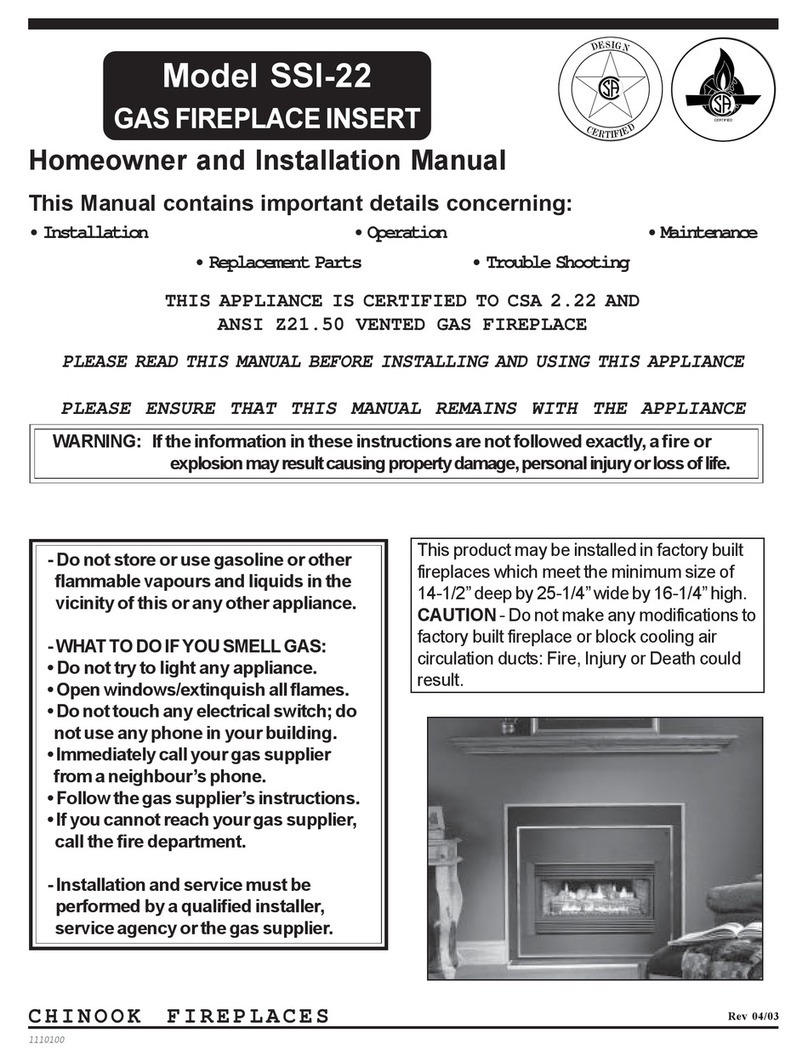
Page 4
Installation and service must be performed by a qualified
technician, service agency or your gas supplier.
When installing this gas appliance, the installation must
conform with local codes or, in the absence of local codes,
with the National Fuel Gas Code, ANSI Z223.1, or the Ca-
nadian Installation Code, CSA -B149.
*This unit is approved in Canada from 0 - 4500' altitude.
For altitudes above 2000' in the United States, consult
NFPA #54 ANSI Z223.1 latest edition for altitude derate
requirements.
Model
SBI-30-NG
SBI-30-LP
BWI-30-NG
BWI-30-LP
Gas Control
Millivolt
Millivolt
Millivolt
Millivolt
Fuel
Natural Gas
Propane
Natural Gas
Propane
Max
Input
B.T.U.H.
30,000
30,000
30,000
30,000
Min
Input*
B.T.U.H.
20,000
20,000
20,000
20,000
•A shut-off valve must be installed to allow the appliance
to be serviced.
•Burner assembly with pilot safety control comes com-
pletely assembled from the factory.
•Connect a 3/8" N.P.T. line to the inlet of the control valve
through hole provided in right side of the outer casing.
•Connections should be made so that the assembly
can be removed at a later date for servicing.
•The appliance and its individual shutoff valve must
be disconnected from the gas supply piping system,
during any pressure testing of that system at test
pressures in excess of 1/2 psig (3.5kPa).
•The appliance must be isolated from the gas supply piping
system by closing its individual manual shut-off valve during
any pressure testing of the gas supply piping system at test pres-
sures equal to or less than 1/2 psig (3.4kPa).
•A knockout is provided on the right, left and bottom
of the appliance for the gas line.
IMPORTANT: Always check for gas leaks with
a mild soap and water solution. Do not use an
open flame for leak testing.
WARNING: When purging the gas line, the
glassfront must be removed.
GAS SPECIFICATIONS
(*Applies to units equipped with turn down controls.)
GAS INLET & MANIFOLD PRESSURES
NATURAL GAS PROPANE
Input Minimum 4.5” wc 11” wc
Input Maximum 10.5” wc 13 ” wc
Manifold Pressure 3.5” wc 10 “ wc
ELECTRICAL - FAN 120V, 60HZ, Less than 5 AMPS
GAS CONNECTION
•The SIT gas control is equipped with a captured screw
type pressure test point, therefore it is not necessary to
provide a 1/8” test point up-stream of the control.
THIS GAS APPLIANCE MUST HAVE ITS OWN VENT. DO
NOT INTERCONNECT IT WITH ANY OTHER APPLIANCE.
• To ensure proper venting action, this appliance must be
properly connected to a 4” diameter type B-1 vent or a
listed chimney liner. (see Liner Installation Instructions,
Page 5.) Minimum vent height 8’ vertical.
• Refer to the latest edition of the National Fuel Gas Code
ANSI Z223.1 (USA) or CSA-B149 (Canada) for proper
vent installation.
• Remove any chimney flue damper or permanently block
it open.
• Chimney should be cleaned and inspected before in-
stallation.
• Chimney cleanouts must be tight fitting or be sealed to
prevent air from leaking into the chimney.
• This appliance is equipped with a built-in backflow diverter
(draft hood). No additional draft hood is required for the
installation.
• The draft hood is designed to be located in the same
atmospheric pressure zone as the combustion air inlet.
Do not block openings in front face to fireplace cavity.
• The B-1 Vent or listed liner can be installed directly on
top of the flue collar of the appliance. The inner flue of the
vent fits outside the flue collar. (See illustration below.)
The vent is then secured with three sheet metal screws.
• This appliance needs fresh air for safe operation and
must be installed so there are provisions for ad equate
combustion and ventilation air. Follow the latest edition
of ANSI Z223.1 (USA) or CSA-B149 (Canada) require-
ments.
• Check periodically that the vent is unrestricted and a
proper draft is present when the unit is in operation. (See
“Checking Proper Vent Action,” Page 5.)
VENTING
ATTACH
B-VENT TO
COLLAR USING
3 SHEET-METAL
SCREWS
B-VENT OR
CHIMNEY LINER
FLUE COLLAR
WARNING: The Rating Plate indicates the type of gas to
be used in your unit. Do not use a different gas.


































